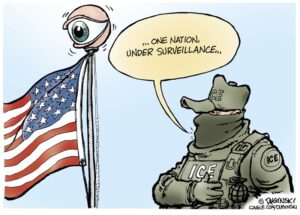
On November 23, 2025, renowned editorial cartoonist Paul Duginski released a powerful cartoon addressing the ongoing surveillance practices of the U.S. Immigration and Customs Enforcement (ICE). The cartoon draws attention to the implications of these surveillance methods, sparking discussions on privacy, security, and civil liberties.
Duginski’s artwork features a stark portrayal of ICE agents equipped with advanced surveillance technology. This imagery serves to highlight the tension between national security efforts and the rights of individuals. By using humor and satire, Duginski encourages viewers to reflect on the balance between safety and personal freedoms in a rapidly evolving technological landscape.
Public Response to Surveillance Critique
The cartoon has elicited a variety of responses from the public and political commentators. Some supporters praise Duginski for shedding light on what they view as overreach by ICE. Critics argue that the depiction misrepresents the intentions of law enforcement agencies.
Social media platforms have been abuzz with reactions, as users share the cartoon widely. Many express gratitude for Duginski’s ability to provoke thought on such a critical issue. Comments range from appreciation for artistic expression to calls for more stringent regulations on surveillance practices.
The Role of Editorial Cartoons in Political Discourse
Editorial cartoons have long been a medium for social commentary and political critique. Duginski’s latest work exemplifies how humor can be a vehicle for serious discussions. In an era where visual media dominates, cartoons can penetrate public consciousness quickly, making complex issues more accessible.
According to the American Civil Liberties Union (ACLU), surveillance programs like those implemented by ICE can infringe on individual rights, often without sufficient oversight. Duginski’s cartoon aligns with these concerns, reinforcing the conversation around the need for accountability in surveillance practices.
As debates continue over immigration policies and law enforcement tactics, Duginski’s work stands as a reminder of the power of art in shaping public opinion. His ability to distill complex issues into relatable imagery keeps critical conversations alive, urging society to reflect on the balance between security and freedom.







